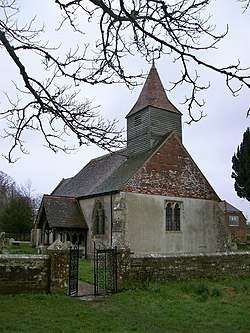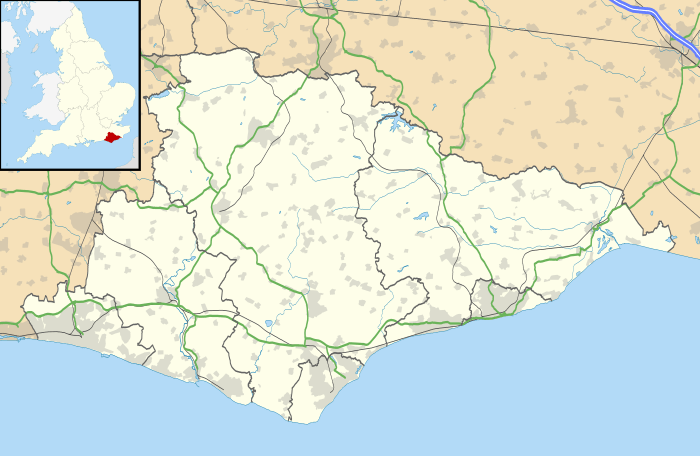Chalvington with Ripe
The civil parish of Chalvington with Ripe, in the Wealden District of East Sussex, England, is made up of the two villages, Chalvington and Ripe. They are located in the upper Rivers Cuckmere and Ouse joint valley north of the South Downs, between the A27 and the A22 roads, and some 15 miles (24 km) north-west of Eastbourne. Ripe is the larger of the two ecclesiastical parishes with 1120 acres (448 ha), compared to the 729 acres (292 ha) of Chalvington.
| Chalvington with Ripe | |
|---|---|
 St Bartholomew's church, Chalvington | |
 Chalvington with Ripe Location within East Sussex | |
| Area | 11.12 km2 (4.29 sq mi) [1] |
| Population | 953 (2011)[2] |
| • Density | 252/sq mi (97/km2) |
| OS grid reference | TQ520094 |
| • London | 46 miles (74 km) NNW |
| District | |
| Shire county | |
| Region | |
| Country | England |
| Sovereign state | United Kingdom |
| Post town | HAILSHAM |
| Postcode district | BN27 |
| Dialling code | 01323 |
| Police | Sussex |
| Fire | East Sussex |
| Ambulance | South East Coast |
| UK Parliament | |
| Website | Chalvington with Ripe |
History of the villages
The Romans built a road through the two villages, and remains of the layout can still be seen.
In medieval times the area had a profitable wool trade.[3]
The villages
Chalvington
The village of Chalvington (Charnton in the traditional Sussex dialect) is named Calvintone or Caveltone in the Domesday Book. It is located in the area between the A27 and the A22 roads, some 15 miles (24 km) north-west of Eastbourne. The name Chalvington, comes from the Saxon Caelfa's farm, and many local names derive from their occupation of the area.
There is one public house in the village, the Yew Tree Inn. The parish church is dedicated to St Bartholomew.[4]
Ripe
Ripe is a village within the Wealden District of East Sussex, England. It is located eight miles (13 km) east of Lewes in the valley north of the South Downs. The two villages are adjacent to one another, Ripe ecclesiastical parish being the larger of the two in area. There is limited public transport to the village.
The village, in a mainly rural area, is mentioned in the Domesday Book and has had a number of names, including Alchitone, Achiltone, Achintone, Echentone and Eckington. The 13th-century parish church is dedicated to St John the Baptist.[5] There is limited public transport to the village.
At the end of the Anglo-Saxon period it was owned by Earl Harold Godwinson, who become King Harold II and was killed at the Battle of Hastings in 1066. The Domesday Book mentions 'Rype' and 'Echentone' which were owned by Richer de Aquila (L'Aigle), and the church is also mentioned in the 1291 Pope Nicholas IV Taxatio ecclesiastical tax assessment survey.
The novelist Malcolm Lowry, best known for Under the Volcano, died at age 47 in a boarding house in Ripe on 27 June 1957. Lowry is buried in the village churchyard. Ripe was also the retirement home of the tattooed performer Horace Ridler (the Great Omi) who died there in 1969.[6]
There was one public house, now closed.
References
- "East Sussex in Figures". East Sussex County Council. Retrieved 26 April 2008.
- "Civil Parish population 2011". Retrieved 8 October 2015.
- A brief history of the parish Archived December 2, 2008, at the Wayback Machine
- St Bartholomew's church Archived March 4, 2016, at the Wayback Machine
- Photographs of Ripe church Archived March 4, 2016, at the Wayback Machine
- Eccles, John (26 January 2006). "Villagers made strange Omi one of their own". Sussex Express. Johnston Press Digital Publishing. Retrieved 4 May 2008.